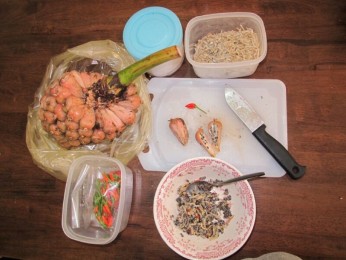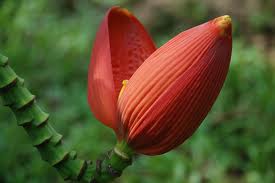Yoga Blog
NOVEMBER 25, 2012
Edible Flowers Of Asia
Posted by Dorothy under Community Interests![]() no responses
no responses
Parts of plants that people commonly associate with being edible are mostly the leaves and fruits. Flowers are mainly used for decoration and of course an important reproduction tool for the plants. Below I would like to share with you two of the most interesting flowers which can be consumed.
Bunga Kantan
The pink buds of Bunga Kantan ( Bunga Siantan aka wild ginger flower or Etlingera Elatior ) is commonly found in a curry based dish from the Peranakan culture ( merger of Chinese and Malay ). This dish called the Nyonya laksa can be found in Malaysia, Singapore and Indonesia but is more popular in Malaysia, mainly the states of Malacca and Penang.
I find the taste and color of this mildly tangy, sweet and fragrant flower interesting and thought it a little underused. Hence, I would like to introduce the use of the bunga kantan flower bud in a few dishes. My favorite use of it is in salads. It can easily replace lemon juice, which is a common acid based ingredient. In a one person portion salad, I suggest the use of half a flower bud, thinly sliced and chopped. Other than that, you can also use it to spice up your fried rice dish. Just throw the chopped bits into the rice when you are almost done frying the rice and mix it well.
I hope to find more uses of the bunga kantan flower bud but at the moment, I have to be contented with these 3 recipes. If any of you readers have been using it in your cooking, please feel free to share it with me.
Now, let’s put the flower buds aside and discover the use of its fruits. I have never seen a bunga kantan bud flowering and producing fruits myself but apparently it looks a little bit between a pineapple and a pandanus fruit but pinkish-white in colour. A close friend, now living in Sabah recently told me that the Sabahans use these fruits in a type of chilli-pickle side dish. She said that the ripe seed pods (smaller than the seeds of passion fruit ) from the fruit is mixed with diced up birds eye chillies, salt and pan roasted fine anchovies. This can then be kept in a jar for some period of time and eaten with warm steamed rice.
Jantung Pisang
Jantung Pisang literally means ‘heart of banana’ although this part of the plant is not actually the heart of the plant it is somehow shaped like a heart, usually dark purplish in colour. It is actually made of layers of the whitish banana flowers enveloped in purplish skin-like sheets. When allowed to grow, these sheets would drop on the ground exposing the rows of flowers, ready to bloom and be pollinated by various insects to produce the bananas that we all love to eat.
The jantung pisang can be eaten but it has to be cooked (either boiled or steamed) first as it contains high content of sap when raw. It can be cooked in broth-like dishes with herbs and coconut milk or it can be presented like salad with a dip. These dishes are mainly eaten in Indonesia, Thailand and Malaysia. The main ingredient to be used either in the broth or the dip is a rhizome called cekur ( Kaempferia galangal ) pounded along with chilli, shallots, garlic & coconut milk, sometimes with grated coconuts too.
2N 3D Langkawi Yoga & Nature Retreat 2012
4N 5D Langkawi Yoga & Nature Retreat 2012
Langkawi Ayurveda & Yoga Retreat
Add New Comment
Category
- Community Interests (55)
- Interesting Reads (32)
- Langkawi (3)
- Media Features (8)
- Natural Highs (29)
- Philosophy (41)
- Welcome (1)
- Wellness (42)
- Yoga Retreat (3)
Archive
- February 2014 (1)
- December 2013 (1)
- November 2013 (1)
- September 2013 (1)
- August 2013 (1)
- July 2013 (1)
- June 2013 (1)
- May 2013 (1)
- April 2013 (1)
- March 2013 (1)
- February 2013 (2)
- January 2013 (2)
- December 2012 (1)
- November 2012 (2)
- October 2012 (2)
- September 2012 (1)
- August 2012 (2)
- July 2012 (2)
- June 2012 (1)
- May 2012 (2)
- April 2012 (2)
- March 2012 (2)
- February 2012 (3)
- January 2012 (2)
- December 2011 (3)
- November 2011 (2)
- October 2011 (2)
- September 2011 (2)
- August 2011 (2)
- July 2011 (2)
- June 2011 (2)
- May 2011 (2)
- April 2011 (2)
- March 2011 (2)
- February 2011 (2)
- January 2011 (2)
- December 2010 (2)
- November 2010 (2)
- October 2010 (2)
- September 2010 (2)
- August 2010 (1)
- July 2010 (2)
- June 2010 (2)
- May 2010 (4)
- April 2010 (3)
- March 2010 (4)
- February 2010 (4)
- December 2009 (1)
- November 2009 (3)
- October 2009 (4)
Upcoming Retreats
7 – 9 March 2014
Langkawi
Yoga at sunrise by a beautiful sandy beach to a pampering session at the spa or a guided nature tour; not to be missed, the sunset yoga session at the yoga deck of our retreat centre amongst tropical trees, made lively with chirping birds, curious monkeys and fluttering butterflies.
weekend yoga retreat package


Comments (0)
Be the first to add comment.